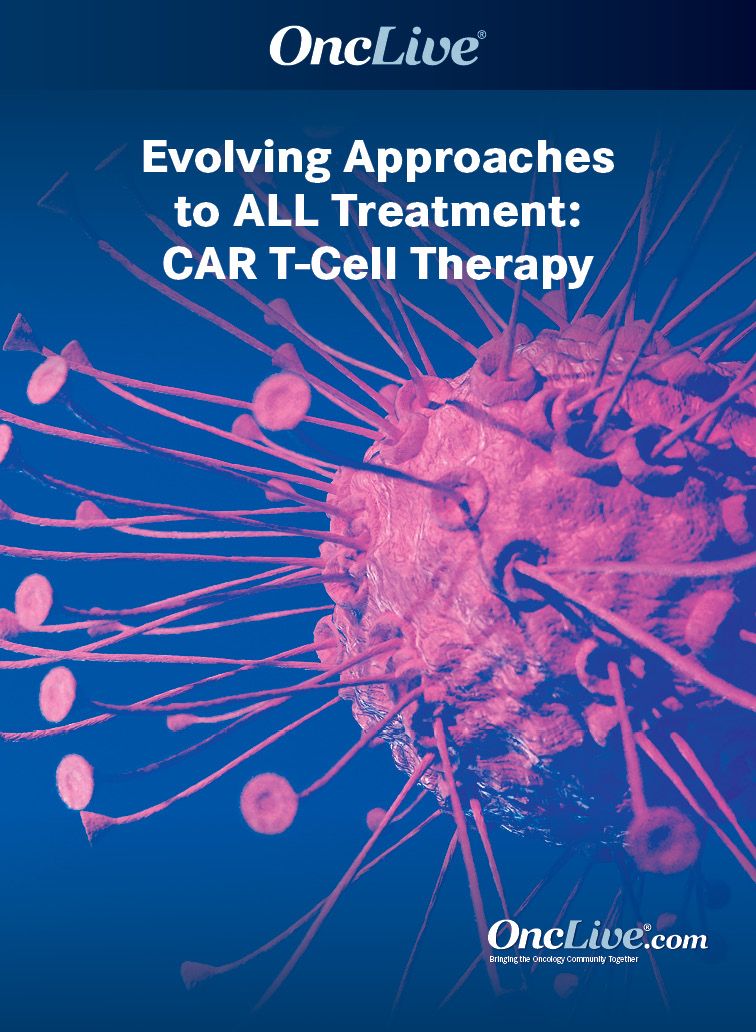Publication
Article
Supplements and Featured Publications
Obe-cel May Mark Additional Treatment Option for R/R B-ALL
Author(s):
Efforts are underway to evaluate novel, durable treatment options for adult patients with relapsed or refractory B-cell acute lymphoblastic leukemia in the phase 1b/2 FELIX trial evaluating obecabtagene autoleucel, a novel, second-generation CAR T-cell therapy.
Bijal Shah, MD, MS

Long-term remissions for adult patients with relapsed or refractory B-cell acute lymphoblastic leukemia (B-ALL) have eluded investigators using combination chemotherapy approaches. Despite initial responses to treatment, more than 50% of patients will ultimately experience disease progression, which is associated with poor prognosis.1 Efforts are underway to evaluate novel, durable treatment options for this patient population in the phase 1b/2 FELIX trial (NCT04404660) evaluating obecabtagene autoleucel (obe-cel; AUTO1), a novel, second-generation chimeric antigen receptor (CAR) product.
CD19-directed CAR T-cell products such as tisagenlecleucel (Kymriah) initially demonstrated efficacy with durable remissions and long-term persistence; however, the patient population was pediatric patients with relapsed or refractory B-ALL, who account for upward of 75% of all B-ALL cases.1,2 Tisagenlecleucel was approved by the FDA on August 30, 2017, for the treatment of patients up to age 25 with B-ALL after 2 prior lines of therapy, or after failure or intolerance of a second-generation tyrosine kinase inhibitor.3
In October 2021, the FDA approved brexucabtagene autoleucel (Tecartus), the first CD19–directed CAR T-cell therapy for use in adult patients with relapsed/refractory B-ALL, including after the first relapse.
Investigators hope obe-cel will provde an additional CD19–directed CAR T-cell option to their arsenal.4,5 Obe-cel’s unique mechanism of action mimics physiological T-cell receptor interactions. The agent has a lower affinity for CD19 than similar CAR T products. This design helps to avoid CAR T-cell over-activation and exhaustion. Further, the half-life of the target interaction of obe-cel is 9.8 seconds compared with 21 minutes with tisagenlecleucel.5,6 In 2019, the FDA granted obe-cel an orphan drug designation.5
“With obe-cel, [investigators] tried to develop a low-affinity CD19 binder that would allow the CAR T cells to rapidly bind and then release,” Bijal Shah, MD, MS, an associate member of the Department of Malignant Hematology at Moffitt Cancer Center in Tampa, Florida, said in an interview with OncologyLive®. “The hope was this would do 2 things: the first was that it would decrease [some of] the toxicity associated with CAR T-cell therapy, specifically cytokine release syndrome [CRS] and neurologic adverse effects [AEs]. [The second, that it] would improve the health of the T cell and limit T-cell exhaustion so the T cells can stay active for a longer period.”
Obe-Cel Generates Early Efficacy
Investigators previously evaluated obe-cel for safety and initial efficacy in the phase 1, single-arm, multicenter ALLCAR19 trial (NCT02935257). A total of 25 patients with relapsed/refractory B-ALL aged 16 or older underwent leukapheresis. The median age of participants was 41.5 years (range, 18-62) and a majority of patients were male (65%). Patients had a median of 3 (range, 2-6) prior lines of treatment, including inotuzumab ozogamicin (Besponsa; 50%) and blinatumomab (Blincyto; 25%). Most had also received prior allogeneic hematopoietic stem cell transplantation (65%).7,8
Twenty-four CAR T-cell products were manufactured, and 20 patients were ultimately infused with obe-cel. Prior to infusion, patients underwent lymphodepletion with 30 mg/m2 of intravenous fludarabine over 3 days and a single 60-mg/kg dose of cyclophosphamide. Obe-cel was given in a split-dose schedule; patients with more than 20% blasts received 10 × 106 CAR T cells and patients with blasts of 20% or less received 100 × 106 CAR T cells on day 0. The second dose was given at an interval of 9 days for a total dose of 410 × 106 CAR T cells.
Findings showed that the event-free survival (EFS) rates for patients who received obe-cel were 68.3% (95% CI, 42.4%-84.4%) at 6 months and 48.3% (95% CI, 23.1%-69.7%) at 12 months when measured by morphologic relapse criteria. This response was maintained at 24 months with an EFS rate of 68.3% (95% CI, 23.1%-69.7%). The overall survival (OS) rates were 69.1% (95% CI, 43.6%-84.8%), 63.8% (95% CI, 38.6%-80.8%), and 58.0% (95% CI, 33.1%-76.4%) at 6, 12, and 24 months, respectively. Additionally, 85% (95% CI, 62.1%-96.7%) of patients with a response (n = 20) achieved minimal residual disease (MRD)-negative complete response (CR) at month 1, and 70% (95% CI, 45.7%-88.1%) experienced an ongoing MRD-negative CR at month 3.
“What [investigators] are seeing with follow-up is that many of these responses are maintained,” Shah said. “The EFS looks like it is going to be about 1 year [based on the] curves, and that is outstanding; it is a signal for an effective CAR T-cell product. The CAR T cells also seem to persist over time, which seems to be encouraging in terms of helping to mitigate against subsequent relapse. We need to prove that, but the early data are certainly promising.”
In terms of safety, no cytokine release syndrome (CRS) events of grade 3 or higher were reported. Grade 1 and 2 CRS events were observed in 15% and 30% of patients, respectively. Investigators reported grade 4 thrombocytopenia among 70% of patients, and grade 1/2 and grade 3 in a small portion of patients (15%). All patients experienced an infection of any grade.
The tolerable safety profile of obe-cel coupled with high remission rates and persistence for adult patients with relapsed/refractory B-ALL provided the rationale for the FELIX trial.
During the 63rd American Society of Hematology Annual Meeting and Exposition, investigators presented initial efficacy and safety data from the phase 1b part of FELIX. At the data cutoff date of September 13, 2021, results showed that among the 16 patients who had been treated with obe-cel, the overall response rate (ORR) was 75% (95% CI, 48%-93%). At 1 month after obe-cel administration, 12 patients had achieved a CR or CR with incomplete recovery of counts, which was comparable with 85% of patients at the same point in the ALLCAR19 study.9,10
In terms of safety, CRS of any grade was reported in 56% of patients; no grade 3 or greater CRS events were reported. Neurotoxicity of any grade was seen in 13% of patients, with 6% experiencing an event of grade 3 or higher. Grade 3 immune effector cell–associated neurotoxicity syndrome was reported in 1 patient.9,10
The median age of patients included in the report was 42 years. Most patients had bone marrow blasts over 20% and had previously been treated with blinatumomab (75% and 56%, respectively). Twenty-five percent of patients had less than 5% bone marrow blasts.9 Autolus Therapeutics, the manufacturer of obe-cel, expects to present data from the pivotal phase 2 portion of the study in 2022.5
Details of the FELIX Trial
The open label, multicenter, single-arm study is enrolling adult patients with relapsed or refractory B-ALL, with a target total of approximately 185 patients. All enrolled patients will sequentially complete screening, leukapheresis, preconditioning with cyclophosphamide and fludarabine chemotherapy, treatment, and follow-up stages. A total target dose of 410 × 106 CAR T cells is administered to all patients on day 1 and day 10 as a split dose, plus or minus 2 days.11
“[What] distinguishes the FELIX trial is [that it is using] fractionated infusion,” Shah said. “We saw some of these data come from Noelle V. Frey, MD, and colleagues when they were using tisagenlecleucel in adult patients [in a phase 1 trial (NCT03620058)]. They would give the CAR T-cell product on day 1, day 2, and day 3, but the dose would be fractionated so that if [patients] experienced severe CRS before the second or third day, they would not receive the full dose of the product. This was to improve safety, particularly as they went up on the total cell dose. They did succeed in that regard, and this set the stage for other approaches looking at fractionated infusion.”
In the phase 1b and 2 portions, patients must have 5% or greater blasts in bone marrow at screening to be included in the primary cohort. Exploratory cohorts will include those with MRD-positive disease, defined as at least detectable disease at 1 × 10-4 and less than 5% blasts in the bone marrow at screening. Patients previously treated with a CD19-targeted therapy other than blinatumomab and those who have experienced neurotoxicity of grade 3 or higher following treatment with blinatumomab will not be included in the trial.11
The primary end points of the phase 1b portion are to identify the frequency and severity of AEs and serious AEs occurring up to 24 months after treatment with obe-cel. In phase 2, the primary end point is ORR. Secondary end points in phase 2 include duration of response, progression-free survival, OS, and safety. The trial is estimated to be completed in April 2024.
Refe-rences
- B-lymphoblastic leukemia/lymphoma, NOS. National Cancer Institute Surveillance, Epidemiology, and End Results Program. Accessed February 22, 2022. bit.ly/3JKnxzg
- Maude SL, Laetsch TW, Buechner J, et al. Tisagenlecleucel in children and young adults with B-cell lymphoblastic leukemia. N Engl J Med. 2018;378(5):439-448. doi:10.1056/NEJMoa1709866
- O’Leary MC, Lu X, Huang Y, et al. FDA approval summary: tisagenlecleucel for treatment of patients with relapsed or refractory B-cell precursor acute lymphoblastic leukemia. Clin Cancer Res. 2019;25(4):1142-1146. doi:10.1158/1078-0432.CCR-18-2035
- FDA approves brexucabtagene autoleucel for relapsed or refractory B-cell precursor acute lymphoblastic leukemia. FDA. Updated October 1, 2021. Accessed February 22, 2022. bit.ly/3IbRvf3
- Developing next generation programmed T cell therapies. Autolus Therapeutics. January 2022. Accessed February 22, 2022. bit.ly/3t2ydSX
- Developing a transformational treatment for adult acute lymphoblastic leukemia. Autolus Therapeutics. Accessed February 22, 2022. bit.ly/3BFErfL
- Roddie C, Dias J, O’Reilly MA, et al. Durable responses and low toxicity after fast off-rate CD19 chimeric antigen receptor-T therapy in adults with relapsed or refractory B-cell acute lymphoblastic leukemia. J Clin Oncol. 2021;39(30):3352-3363. doi:10.1200/ JCO.21.00917
- Immunotherapy for high risk/relapsed CD19+ acute lymphoblastic leukaemia, B-cell non-Hodgkin’s lymphoma (B-NHL) and chronic lymphocytic leukaemia (CLL)/ small lymphocytic lymphoma (SLL) using CAR T-cells to target CD19 (ALLCAR19). ClinicalTrials.gov. Updated November 23, 2020. Accessed February 18, 2022. https:// clinicaltrials.gov/ct2/show/NCT02935257
- Cushaw A, Vargas FA, Toledo GS, et al. Industrialization of an academic Miltenyi Prodigy-based CAR T process. Blood. 2021;138(suppl 1):477. doi:10.1182/blood-2021-153031
- Obe-cel data update – ASH 2021. Autolus Therapeutics. December 2021. Accessed February 22, 2022. bit.ly/3BFfsZX
- A study of CD19 targeted CAR T cell therapy in adult patients with relapsed or refractory B cell acute lymphoblastic leukaemia (ALL). ClinicalTrials.gov. Updated January 5, 2022. Accessed February 18, 2022. https://clinicaltrials.gov/ct2/show/NCT04404660










